Streptopelia
capicola (Cape Turtle Dove)
Gewone tortelduif [Afrikaans]; Ihobe,
Untamnyama [Xhosa]; iHophe (also Red-eyed dove), uSamdokwe [Zulu]; Haikonda
(generic term for turtle dove) [Kwangali]; Leebana-khoroana (also applied to
Red-eyed dove and Laughing dove), Lekunkuroane [South Sotho]; Leaba kgorwana
[North Sotho]; Njiva (also applied to Laughing dove) [Shona]; Lituba (also
applied to Laughing dove) [Swazi]; Tuva [Tsonga]; Leeba, Lephôi, Mhiri
[Tswana]; Kaapse tortel [Dutch]; Tourterelle du Cap [French]; Kapturteltaube,
Gurrtaube, Kaplachtaube [German]; Rola do Cabo [Portuguese]
Life
> Eukaryotes >
Opisthokonta
> Metazoa (animals) >
Bilateria >
Deuterostomia > Chordata >
Craniata > Vertebrata (vertebrates) > Gnathostomata (jawed
vertebrates) > Teleostomi (teleost fish) > Osteichthyes (bony fish) > Class:
Sarcopterygii (lobe-finned
fish) > Stegocephalia (terrestrial
vertebrates) > Tetrapoda
(four-legged vertebrates) > Reptiliomorpha > Amniota >
Reptilia (reptiles) >
Romeriida > Diapsida > Archosauromorpha > Archosauria >
Dinosauria
(dinosaurs) > Saurischia > Theropoda (bipedal predatory dinosaurs) >
Coelurosauria > Maniraptora > Aves
(birds) > Order: Columbiformes > Family:
Columbidae > Streptopelia
The Cape turtle-dove is extremely common, and is found
everywhere in southern Africa. It lives in most types of
woodland, as well as farmland, suburban parks and gardens. It mainly eats seeds,
as well as fruit, nectar, leaves and insects. It usually makes its own nest, out
of twigs, leaves and roots, but can also use nests made by other birds. It lays 1-4 eggs, usually 2, which are incubated by
both sexes, for 13-16 days. The nestlings stay in the nest for 16-17 days, after
which they are dependent on their parents for 12 more days before becoming
fully independent.
Distribution and habitat
Occurs from Ethiopia south through Tanzania, southern DRC,
Zambia and Angola to southern Africa. It is one of the most prolific birds in
southern Africa, occurring across the region in woodland, farmland, suburban parks and gardens. It often nests,
roost and eats in and around alien trees, such as Port Jackson Willow (Acacia saligna), Rooikrans
(Acacia cyclops), pines (Pinus)
and eucalyptus trees (Eucalyptus).
|
 |
|
Distribution of Cape turtle-dove in southern Africa,
based on statistical smoothing of the records from first SA Bird Atlas
Project (©
Animal Demography unit, University of
Cape Town; smoothing by Birgit Erni and Francesca Little). Colours range
from dark blue (most common) through to yellow (least common).
See here for the latest distribution
from the SABAP2. |
Predators and parasites
- Predators
- of adults
- of chicks and/or eggs
Food
It mainly eats seeds, supplemented with fruit, nectar,
leaves and invertebrates. It usually forages
on the ground, looking for seeds and fallen fruits. The following species have
been recorded in its diet:
- Plants
- seeds:
- cultivated plants
- sorghum
- grasses
- maize
- oats
- lupins
- Euphorbia (milkweeds)
- Ulmus (alien elm)
- Acacia
- Acacia cyclops (Rooikrans)
- Acacia saligna (Port Jackson Willow)
- Acacia melanoxylon (Australian blackwood)
- Acacia mearnsii (Black wattle)
- Pinus (pines)
- Quercus robur (Common oak acorns)
- Eucalyptus camaldulensis (Red river gum)
- fruits
- Pyrecantha (Firethorns)
- Rhus (Taaibos)
- Lantana camara (Cherry-pie)
- succulent leaves
- allen, protected sugar capsules of psyllids (Psyllidea) under Mopane
trees (Colophospermum mopane).
- nectar of
Aloe marlothii (Mountain
Aloe)
- Invertebrates
- earthworms
-
termites
- weevils
- aphids
- locust hoppers
Breeding
- The female usually makes the nest in 3-8 days, doing
most of the work in the early morning. The nest is a small platform of
twigs, grass, roots and sometimes pine needles, usually about 15cm wide.
It is typically placed in the fork of a tree, surrounded by dense foliage
and
often in suburban gardens or parks. Sometimes, the female will repair a nest
from the previous season, instead of making a new one. It also uses nests of
other birds, such as
doves and pigeons,
egrets,
thrushes and
sparrows.
- Egg-laying season is year-round, peaking from August-November in winter
rainfall areas.
- It lays 1-2, rarely 4 eggs, which are incubated by both parents for
about 13-16 days; the male incubates
from about 10h00-16h00 and the female does the rest.
- Once the chicks hatch, the egg shells are immediately thrown out
of the nest. They are fed and brooded by both parents, leaving the nest for
the adjacent bush after about 16-17 days. They are dependent on their parents for
approximately 12 more days.
Threats
Not threatened, in fact common in most areas of southern
Africa. Hunted for sport and food, but this does not seem to damage its
population significantly.
References
-
Hockey PAR, Dean WRJ and Ryan PG 2005. Roberts
- Birds of southern Africa, VIIth ed. The Trustees of the John Voelcker
Bird Book Fund, Cape Town.
|
